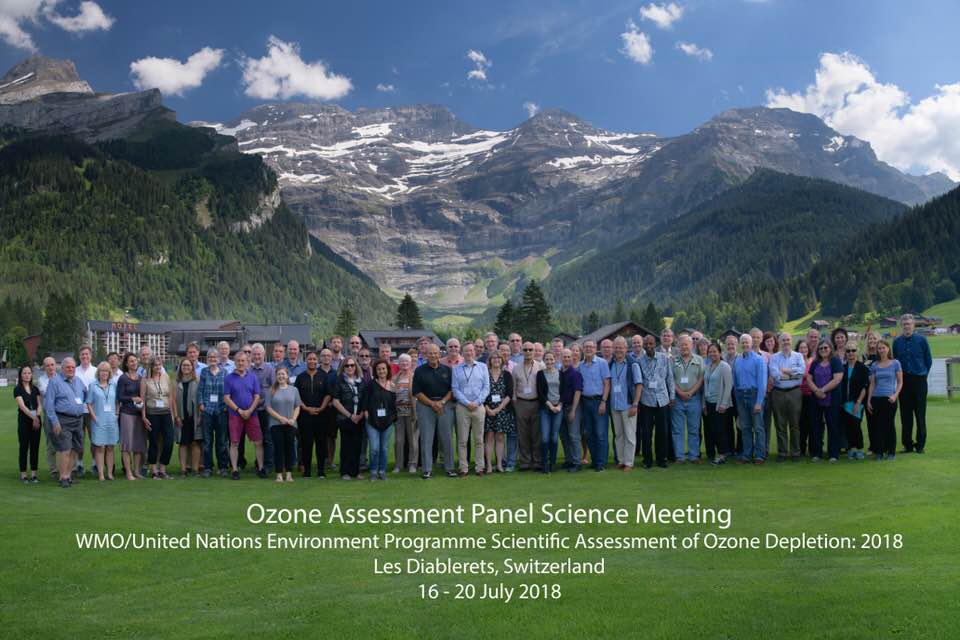A .gov website belongs to an official government organization in the United States.
A lock () or https:// means you've safely connected to the .gov website. Share sensitive information only on official, secure websites.
20 July 2018
The Montreal Protocol on Substances that Deplete the Ozone Layer not only protects the Earth's ozone layer, but also protects our climate through the adoption of the Kigali Amendment for the regulation of hydrofluorocarbons (HFCs).

CSD Director David Fahey, co-chair of the Montreal Protocol Scientific Assessment Panel, helped lead the 2018 Scientific Assessment of Ozone Depletion final author team meeting in Les Diablerets, Switzerland from 16-20 July. Attendees, including ESRL scientists and staff, discussed and finalized the assessment's Executive Summary to be released by the Ozone Secretariat this fall.
The 2018 Scientific Assessment of Ozone Depletion is the 9th in the series. For each quadrennial assessment, CSD (and formerly the Aeronomy Laboratory) has assumed the large responsibilities of coordinating the assessment process (e.g., co-chair, author, and reviewer communication, assembling draft versions, meeting planning) and producing the final documents (main document, executive summary and 20 Questions and Answers booklet), which involves editing, layout, printing, and distributing.
CSD Director David Fahey attended a meeting of the Parties to the Montreal Protocol in Vienna, Austria the week prior to the Switzerland meeting. The Scientific Assessment Panel contributes scientific information, as needed, and generally updates the parties with a plenary presentation on the state of its assessment and any breaking topics. This meeting focused on new evidence that global emissions of a banned compound, CFC-11, have increased significantly in recent years, as published last month in Nature by GMD's Steve Montzka, with CSD authors studying the potential role of dynamics in the analysis. The paper concludes that unreported emissions of this banned substance are likely coming from East Asia. As such, this finding represents a challenge to the historically successful Montreal Protocol process of regulating this important ozone-depleting substance. The Scientific Assessment Panel will undertake additional efforts to help identify the source of these emissions.
Montzka, S.A., G.S. Dutton, P. Yu, E. Ray, R. Portmann, J.S. Daniel, L. Kuijpers, B.D. Hall, D. Mondeel, C. Siso, D. Nance, M. Rigby, A. Manning, L. Hu, F. Moore, B.R. Miller, and J.W. Elkins, An unexpected and persistent increase in global emissions of ozone-depleting CFC-11, Nature, doi:10.1038/s41586-018-0106-2, 2018.
The Montreal Protocol was designed to protect the stratospheric ozone layer by enabling reductions in the abundance of ozone-depleting substances such as chlorofluorocarbons (CFCs) in the atmosphere1,2,3. The reduction in the atmospheric concentration of trichlorofluoromethane (CFC-11) has made the second-largest contribution to the decline in the total atmospheric concentration of ozone-depleting chlorine since the 1990s1. However, CFC-11 still contributes one-quarter of all chlorine reaching the stratosphere, and a timely recovery of the stratospheric ozone layer depends on a sustained decline in CFC-11 concentrations1. Here we show that the rate of decline of atmospheric CFC-11 concentrations observed at remote measurement sites was constant from 2002 to 2012, and then slowed by about 50 per cent after 2012. The observed slowdown in the decline of CFC-11 concentration was concurrent with a 50 per cent increase in the mean concentration difference observed between the Northern and Southern Hemispheres, and also with the emergence of strong correlations at the Mauna Loa Observatory between concentrations of CFC-11 and other chemicals associated with anthropogenic emissions. A simple model analysis of our findings suggests an increase in CFC-11 emissions of 13 ± 5 gigagrams per year (25 ± 13 per cent) since 2012, despite reported production being close to zero4 since 2006. Our three-dimensional model simulations confirm the increase in CFC-11 emissions, but indicate that this increase may have been as much as 50 per cent smaller as a result of changes in stratospheric processes or dynamics. The increase in emission of CFC-11 appears unrelated to past production; this suggests unreported new production, which is inconsistent with the Montreal Protocol agreement to phase out global CFC production by 2010.